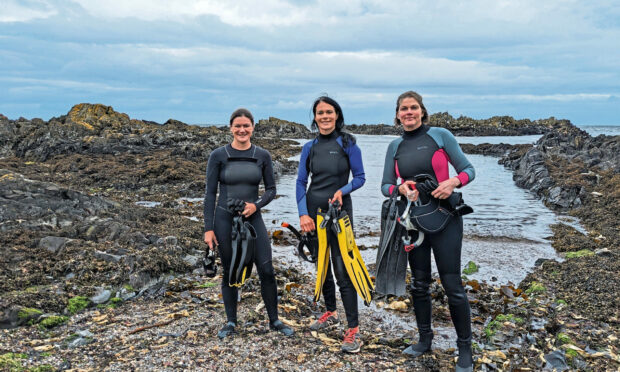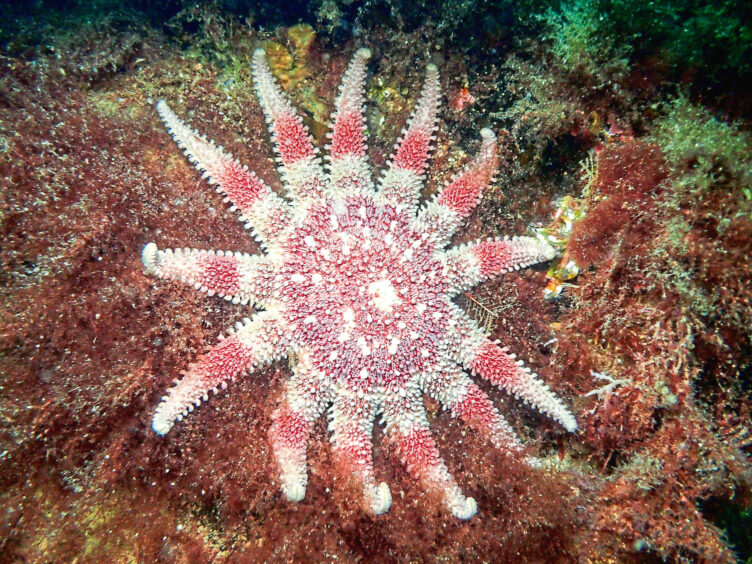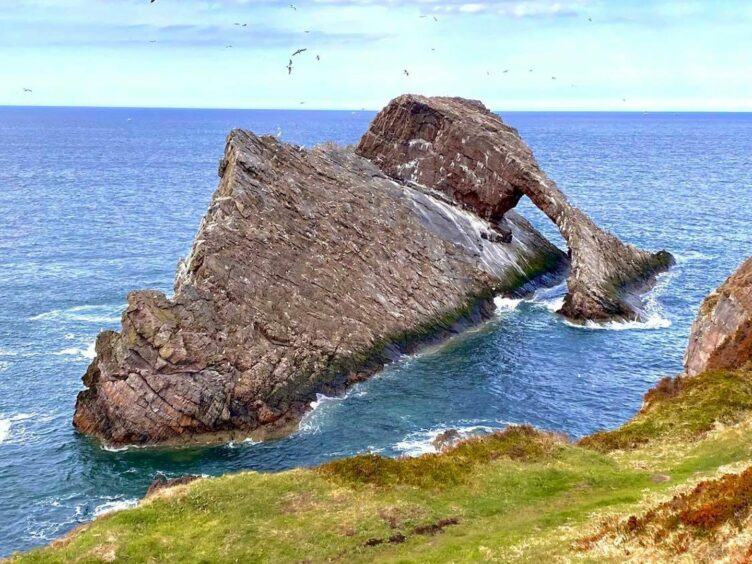As I drive up the coast towards Macduff, the sky blackens and the heavens open.
It’s the middle of July – I’d been expecting temperatures of around 20C and an aquamarine sea sparkling in the sunlight.
I’m on my way to Macduff Marine Aquarium for a bash at snorkelling around the rocky shoreline and, to put it mildly, the conditions aren’t ideal.
When I arrive, I’m reassured by the centre’s learning officer Marie Dare – and marine biologist and scuba diver Lauren Smith – that it’s definitely worth heading out for a look.
Marie and Lauren recently teamed up with the Scottish Wildlife Trust (SWT) to design a series of self-guided snorkel trails along the Moray Firth, and they launched these last month.
The easily accessible Moray snorkel trail
They chose spots they deemed easily accessible, many of them aimed at beginners – with a few for more advanced snorkellers – all teeming with magnificent marine life.
Lauren, who’s employed by the East Grampian Coastal Partnership as project manager for the Turning the Plastic Tide project, tackling marine litter through beach cleans, says people are often surprised to discover there are fantastic opportunities for snorkelling here.
“It’s amazing to be able to encourage people to explore this wonderful underwater world,” she enthuses.
“Anybody who’s comfortable in the water can grab a snorkel and give it a go – even if you’ve never done it before.
“You can just go in the shallows until you’re comfortable. That’s the great thing about the sites we’ve identified. They’re all quite accessible, but if you gain confidence, you can carry on up and down the coastline.”
Kelp gullies
Marie, who hails from Barbados, is wild about the kelp gullies, and what she refers to as “swim-throughs” – arches and tunnels you can quite literally swim through.
“You don’t have to cover a huge distance to see loads of marine life,” she notes. “You can hang out in a small area and see crabs, jellyfish and tiny nudibranches (types of sea slugs with boneless bodies that often boast eye-catching colours and patterns).
“It’s such a great environment for life. You can lie on your belly at low tide and see critters on the kelp.”
Comb jellyfish
Lauren is particularly excited about “comb jellyfish”, having spotted blooms of them drifting in the sea near Portknockie.
“They’re mesmerising,” she beams. “And comb jellies have this amazing ability to generate light.”
Snorkelling adventure
The aquarium is a great starting point for a snorkelling adventure, and once we’re kitted out in wetsuits, flippers, gloves, hoods, masks and snorkels, the three of us set off in search of a good spot.
We find a great range of tidal pools at High Shore beach, and Marie reveals you can often spot octopus in the kelp gullies – the aquarium sometimes releases them here.
Heavy rain and a breeze haven’t helped visibility, alas. The water is quite cloudy and reduces our chances of spotting the myriad curious creatures that lurk beneath the waves.
Curious creatures
As we chat in the shallows, Lauren gives me a rundown of some of the species we might encounter: long-spined sea scorpions, shore crabs, velvet swimming crabs, dog whelks, limpets, periwinkles, common urchins, starfish, dahlia anemone, Yarrell’s blenny, pollack and plaice.
If we’re really lucky, we might see lesser spotted dogfish, monkfish, bottlenose dolphins and seals.
I float around for a good 20 minutes, marvelling at the colourful seaweeds. There’s sugar kelp, bladder wrack and possibly (but I could be mistaken) thong weed. However, there aren’t many critters out to play today.
When the water is clear, snorkelling can be absolutely spellbinding, giving you incredible access to this mysterious watery underworld.
The best time to do it is during low tide in mid to late summer after a long, settled spell of weather. The less sediment that’s been swept around, the clearer the water will be and the more marine life you’ll see.
Captivating coastline along the Moray snorkel trail
Alongside High Shore, Marie and Lauren – in tandem with SWT – devised another five snorkel trails along the captivating coastline.
These are: an iconic location overlooking the natural sea arch of Bow Fiddle Rock at Portknockie; Portsoy pool; Black Pots at Whitehills; Cullykhan Bay near Fraserburgh; and the old tidal pools at Tarlair, near the Needle’s Eye rock formation.
Whatever the weather, it’s worth giving snorkelling a bash – you never know what you might find, and even if you see very little, what’s not to like about getting out into the great outdoors, breathing in some fresh coastal air, and being at one with nature?
Promote health and wellbeing
Marie agrees: “It’s all about promoting health and wellbeing, engaging with nature, and appreciating the abundance and diversity of wildlife.
“When people get the chance to see native species in its natural habitat, it can cement the concept of care, conservation and stewardship of the marine environment.”
It’s also about promoting the idea of the ‘blue mind’ – the calm, meditative state people fall into when they are near, in, under or on water – says Lauren.
So, how do you get started? Get kitted out with snorkelling gear (it’s fairly affordable or you can hire it) and download a snorkel trail leaflet.
Alongside beach maps with beginner and advanced snorkel areas, the leaflets highlight facilities such as toilets, parking and picnic areas, and places to hire kit.
Be aware that snorkelling can be dangerous; you use the self-guided trails at your own risk. Always check the conditions and assess if it’s safe to snorkel before you do so.
- Need to hire snorkelling gear? Check out Cullen-based Blue Coast Surf and Paddle (bluecoastcullen.co.uk), or Sandend-based Suds Surf School (surfschoolscotland.co.uk).
- Find out more about snorkel trails across Scotland, and download leaflets detailing sites including Arran, Berwickshire, East Lothian, Lochaber, Argyll, Harris, North West Highlands, and Torridon – as well as Moray Firth – at scottishwildlifetrust.org.uk/snorkel-trails/
- For more information on Macduff Marine Aquarium, see macduff-aquarium.org.uk






